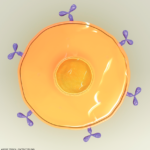2. Inebilizumab for IgG4-Related Disease
Abstract 0775: Stone et al.6
Inebilizumab is a humanized monoclonal antibody directed against CD-19, which is a marker present on a broad range of B cells, including plasmablasts and plasma cells. It is currently FDA approved for the treatment of neuromyelitis optica spectrum disorder (NMOSD), a neuroinflammatory disorder that affects the optic nerves and spinal cord.
MITIGATE was a phase 3 study that randomized 135 patients with IgG4-RD to receive treatment with either inebilizumab (300 mg intravenous infusions on days 1 and 15, and week 26) or placebo, in addition to glucocorticoids, which were tapered over eight weeks.7
At the end of 52 weeks of observations, patients treated with inebilizumab were significantly less likely to experience relapse than patients treated with placebo (hazard ratio 0.13, 95% confidence interval [CI] 0.06, 0.28). The most common adverse events included COVID-19, lymphopenia and urinary tract infections. Serious and/or opportunistic infections were more common among patients treated with inebilizumab than placebo (9% vs. 3%).
B cell depletion with rituximab (a monoclonal antibody directed against CD20) has long been a standard therapy for the treatment of IgG4 RD. CD19 is present on a broader range of cells in the B cell lineage than CD20. Therefore, a monoclonal antibody directed against CD19 should result in deeper depletion of the B cell compartment. There are already data indicating that inebilizumab may be more effective than rituximab for NMOSD.8 Whether the same will be true for IgG4 RD has not yet been established.
3. Low-Dose Glucocorticoids for GPA
Abstract 0774: Merkel et al.9
This study identified 143 patients with granulomatosis with polyangiitis (GPA) who had active disease in the past year and were able to taper their prednisone to 5 mg daily. Patients were randomized to continue taking prednisone 5 mg daily for six months or to taper their prednisone dose to 0 over a period of four weeks.
Overall, patients who remained on low-dose prednisone had a reduced rate of relapse at month 6 (16% vs. 4%; OR 4.2; 95% CI 1.1–15.8). However, subgroup analysis demonstrated this benefit was restricted to patients not using rituximab for remission maintenance (20% vs. 6%; OR 9.5, 95% CI 1.1-81.7). There was no difference between the two arms in patient-reported outcomes, including Patient Reported Outcomes Measurement Information System (PROMIS) Fatigue, Pain Interference and Physical Function scales and the SF-36.


